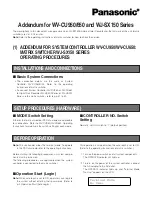
C
HAPTER
15
| Basic Administration Protocols
Simple Network Management Protocol
– 390 –
S
PECIFYING
T
RAP
M
ANAGERS
Use the Administration > SNMP (Configure Trap) page to specify the host
devices to be sent traps and the types of traps to send. Traps indicating
status changes are issued by the switch to the specified trap managers.
You must specify trap managers so that key events are reported by this
switch to your management station (using network management
software). You can specify up to five management stations that will receive
authentication failure messages and other trap messages from the switch.
CLI R
EFERENCES
◆
"snmp-server host" on page 560
◆
"snmp-server enable traps" on page 559
C
OMMAND
U
SAGE
◆
Notifications are issued by the switch as trap messages by default. The
recipient of a trap message does not send a response to the switch.
Traps are therefore not as reliable as inform messages, which include a
request for acknowledgement of receipt. Informs can be used to ensure
that critical information is received by the host. However, note that
informs consume more system resources because they must be kept in
memory until a response is received. Informs also add to network
traffic. You should consider these effects when deciding whether to
issue notifications as traps or informs.
To send an inform to a SNMPv2c host, complete these steps:
1.
Enable the SNMP agent (
page 373
).
2.
Create a view with the required notification messages (
page 376
).
3.
Configure the group (matching the community string specified on
the Configure Trap - Add page) to include the required notify view
(
page 379
).
4.
Enable trap informs as described in the following pages.
To send an inform to a SNMPv3 host, complete these steps:
1.
Enable the SNMP agent (
page 373
).
2.
Create a local SNMPv3 user to use in the message exchange
process (
page 385
). If the user specified in the trap configuration
page does not exist, an SNMPv3 group will be automatically created
using the name of the specified local user, and default settings for
the read, write, and notify view.
3.
Create a view with the required notification messages (
page 376
).
4.
Create a group that includes the required notify view (
page 379
).
5.
Enable trap informs as described in the following pages.
Summary of Contents for ES3510MA
Page 1: ...Management Guide www edge core com 8 Port Layer 2 Fast Ethernet Switch...
Page 4: ...ABOUT THIS GUIDE 4...
Page 30: ...CONTENTS 30...
Page 40: ...FIGURES 40...
Page 46: ...TABLES 46...
Page 48: ...SECTION I Getting Started 48...
Page 72: ...SECTION II Web Configuration 72...
Page 88: ...CHAPTER 3 Using the Web Interface Navigating the Web Browser Interface 88...
Page 116: ...CHAPTER 4 Basic Management Tasks Resetting the System 116...
Page 154: ...CHAPTER 5 Interface Configuration VLAN Trunking 154...
Page 216: ...CHAPTER 8 Spanning Tree Algorithm Configuring Interface Settings for MSTP 216...
Page 350: ...CHAPTER 14 Security Measures DHCP Snooping 350...
Page 440: ...CHAPTER 17 IP Services Displaying the DNS Cache 440...
Page 484: ...CHAPTER 19 Using the Command Line Interface CLI Command Groups 484...
Page 554: ...CHAPTER 21 System Management Commands Switch Clustering 554...
Page 574: ...CHAPTER 22 SNMP Commands 574...
Page 582: ...CHAPTER 23 Remote Monitoring Commands 582...
Page 636: ...CHAPTER 24 Authentication Commands Management IP Filter 636...
Page 736: ...CHAPTER 29 Port Mirroring Commands RSPAN Mirroring Commands 736...
Page 816: ...CHAPTER 34 VLAN Commands Configuring Voice VLANs 816...
Page 830: ...CHAPTER 35 Class of Service Commands Priority Commands Layer 3 and 4 830...
Page 848: ...CHAPTER 36 Quality of Service Commands 848...
Page 900: ...CHAPTER 38 LLDP Commands 900...
Page 910: ...CHAPTER 39 Domain Name Service Commands 910...
Page 916: ...CHAPTER 40 DHCP Commands DHCP Client 916...
Page 948: ...CHAPTER 41 IP Interface Commands IPv6 Interface 948...
Page 950: ...SECTION IV Appendices 950...
Page 982: ...INDEX 982...
Page 983: ......
















































